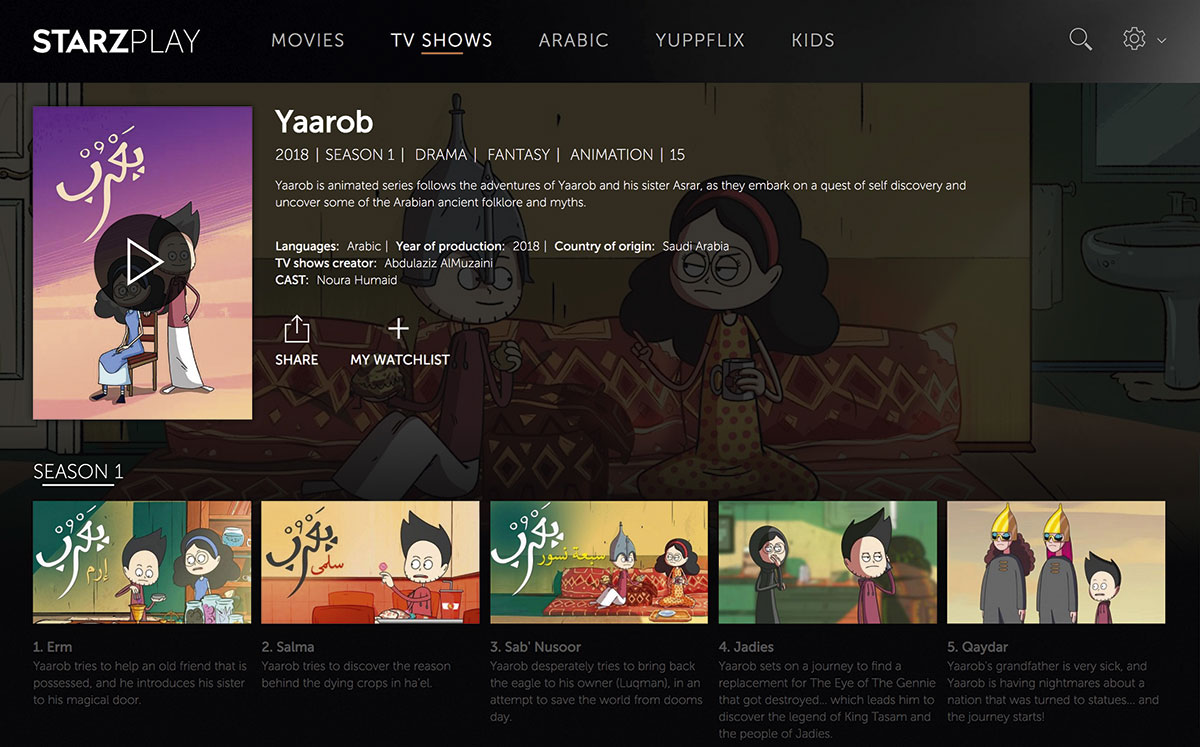
After more than 40 years of operation, DTVE is closing its doors and our website will no longer be updated daily. Thank you for all of your support.
Arabian evolution

Netflix original Jinn is one example of the focus that the streamer is placing on MENA, investing heavily in local content
Under a cloud of piracy and political tensions, the TV industry in MENA still continues to grow. Rebecca Hawkes takes a look at the changing market and how its local attitudes make it stand out from the rest of the world.
Rampant content piracy, video streaming fervour, and continued political tensions in the Gulf have dominated the competitive landscape of pay TV in the Middle East and North Africa (MENA) over the past year.
The two direct-to-home (DTH) heavyweights – UAE-based OSN and Qatar’s beIN Media – have both been dealt blows to their subscription-based businesses in the last 12 months, with OSN’s major shareholder Kuwait Projects Co reportedly looking to sell its 60.5% stake, and beIN cutting its regional workforce by a fifth.
The political backdrop, which saw Saudi Arabia, Egypt, Bahrain, and the UAE cut all diplomatic and economic ties with Qatar in June 2017, has had significant ramifications in the media sector. BeIN Media has been forbidden to legally operate in their territories and has lost an estimated 45% of its subscriber base as a result, although it is now available once again in the UAE on IPTV networks operated by Etisalat and Du, and on CNE in Egypt.
OSN has also suffered setbacks, losing almost 15% of its subscriber base between the second quarter of 2015 and the third quarter of 2017, said IHS Markit in its Pay TV & Online Subscription Video Report 2019. Through slashing prices and launching more flexible packages in 2018, analysts believe it has won back 5% of the subscribers it lost the two previous years, though revenues have taken a hit.
Satellite suppression
As a result of these struggles – along with the ever-present spectre of content piracy – an 8% revenue drop was recorded from 2017 to 2018 across MENA’s entire pay TV sector. Analysts at Digital TV Research suggest that over the two-year period from 2016 pay TV revenues fell 16% from US$1.25 billion to US$1.06 billion across 13 Arab countries.
“BeIN lost around 45% of its subscriptions base and over US$600 million in subscription revenues between the middle of 2017, when the Saudi-led blockade began, until the end of 2018,” says Constantinos Papavassilopoulos, associate director at IHS Markit.
BeIN has also had a well-documented battle with Saudi-based pirate network BeoutQ which recently, after two years of international disapproval, disappeared from the airwaves.
BeIN’s competitor OSN is facing similar major difficulties without enjoying financial backing like beIN. “The decision of OSN’s previous management team to relaunch the brand with more flexibility in subscription packages was mostly unsuccessful,” says Papavassilopoulos. Now, due to financial pressures, it is implementing cost cutting strategies, such as ceasing the broadcast of sports.”
In July, OSN confirmed it has put an end to all sports coverage, discontinuing its Pelha packs at the conclusion of this year’s ICC Cricket World Cup.
This overall scenario is a far cry from 2010-16, when the region’s pay TV market recorded a 17% CAGR, says Papavassilopoulos. It was during this period of growth that Pelha was acquired by OSN to appeal to the large South Asian diaspora living in the Gulf and grow its customer base. However, English and Arabic programming now appear to be the focus for the operator, as it consolidates its programming assets.
Speculation abounds around a rescue plan for OSN, which remains the dominant rights holder of premium Hollywood content in the region until 2022 and offers attractive Arabic content on its Ya Hala channels – though any potential investor would need deep pockets to compete with state-backed beIN Media.
Meanwhile, OSN’s new management team, led by former board member Patrick Tillieux, is focusing on its new low-cost contract-free pack for Saudi Arabian viewers. Called El Farq (The Difference), it offers TV channels from Fox, HBO and Disney for SAR159 (€39) per month.
Its launch followed an OSN study which discovered Saudi Arabian households spend an average of eight hours a day watching TV, explaining why the Kingdom holds such promise for the region’s players.
El Farq officially launched in February 2019 following a three-month pilot, which it stimulated growth in OSN’s subscriber base, particularly in the 25 to 44 age group, OSN’s chief commercial operator Steve MacDiarmid said.
Despite satellite’s struggles, the regional pay TV market did slowly grow to 4.5 million subscriptions by the end of 2018, up 6% from 4.2 million the year before. This increase was spurred by growth in MENA’s IPTV services.
Streaming soars
Saudi Arabia remains the largest MENA market for over-the-top (OTT) video services, followed by the UAE. But while the performance of pay TV is sluggish, video streaming is flourishing in a region dominated by its youthful, tech-savvy, mobile first population.
By the end of 2018, the number of online video subscriptions was equivalent to 40% of pay TV subscriptions, says IHS Markit, although OTT revenue was only 7% the size of pay TV revenue in the region.
Paid subscriptions for online video at the end of 2018 stood at 1.78 million, up 45% year-over-year, while revenues from paid subscriptions reached a high of US$146 million for the year, up 41% year-over-year. OTT video revenues are predicted to reach US$416 million by 2023.
Despite the emphasis on mobile, while Qatar, Saudi Arabia and the UAE have unveiled 5G mobile networks, 4G is yet to take hold across swathes of North Africa.
But, across all the generations of infrastructure, mobile devices remain the favoured method of watching streamed content. At the end of 2018, the number of mobile broadband subscribers in the region was 17 times higher than that of fixed broadband subscribers.
“The pattern of growth for the streaming sector is mimicking the growth of the pay-TV market, geographically, in MENA,” says Papavassilopoulos. “It is strongest in the Gulf, where there is higher disposable income, greater technology awareness, better infrastructure, reliable mobile broadband, and more credit card users.”
Still leading MENA’s SVOD pack is Starz Play Arabia, with a 29% share of the market. Netflix is just behind with 25% of the region’s subscriptions, closely followed by MBC-owned local platform Shahid Plus at 24%.
Netflix and Starz Play accounted for a third of the SVOD market in 2018, as Shahid Plus took 15% of revenues.
Shining bright
At the beginning of 2019, Lionsgate-backed Starz Play Arabia passed the one million subscriber mark and is still growing at a rate of 60% year-over-year, according to CEO and co-founder Maaz Sheikh.
The company could break even this year, Sheikh says, “but we must try to maintain growth and our position in the market.”
To embark on an original production, you have to accept you could create content which will only be successful in one area, and not another. Maaz Sheikh, Starz Play
He continues: “While our shareholders are willing to bet on expansion and invest in growth, we’ll focus on that. It is less of a priority to break even, although the unit economics of each subscriber are important to generate positive cash.”
Each subscriber adds what Sheikh calls a “positive lifetime value”, although the amount each generates for Starz Play varies enormously. To underline that, 80% of the SVOD company’s revenue hail from the Gulf States, despite North Africa providing 30-35% of all Starz Play subscribers.
Starz Play owes its leadership position in large part to its early market entry and drive to forge extensive distribution deals and convenient payment options. It now has, says Sheikh, “a two to three-year window in which to dominate the market, so when the global players do inevitability catch up, we have already established ourselves”.
Among its successful partnerships is one with STC’s aggregated live TV and VOD platform Jawwy TV, for which Starz Play provides the Hollywood content. Currently it operates in Saudi Arabia, Bahrain and Kuwait, though it has ambitions for rolling out further into the region.
In terms of content, Sheikh says Starz Play Arabia is now getting better at understanding not only consumer consumption but what drives unique consumption. Series such as Grey’s Anatomy, The Big Bang Theory, Friends and The Office are binge-viewed and drive high consumption figures – far greater than those of its new ‘day and date’ shows, such as Vikings and Power. “But, on the day a brand-new show hits, we see a 30-40% lift on subscriptions, so these ‘day and date shows’ drive new acquisitions for us,” says Sheikh.
When content comes off Netflix and Starz Play becomes the sole home for it in the region (as happened with The Office), that also has “a very material impact” he adds.
Around 80% of Starz Play’s 6,000 hours of western content is licensed through major studios, while the rest is from minor studios or independent producers. Bollywood is also featured, and the platform offers 2,000 hours of Arabic content, with a raft of classic and modern Egyptian and Lebanese films most recently added to the offer.
Original sin
Local originals are not on the cards for Starz Play anytime soon Sheikh says. “MENA is a market with tons of variability from one country to the next. To embark on an original production, you have to accept you could create content which will only be successful in one area, and not another. To monetise this is a challenge,” he says. “Netflix has started on this journey and for now we have an opportunity to watch and learn. Ultimately it is a natural extension, even for us, to produce local original content to differentiate ourselves from linear broadcasters.” But first, Sheikh believes the entire value chain in the region has to evolve and adapt, from script writing to consumer taste.
Evolution in the local production market has occurred in terms of the creation and consumption of short-form content. Tapping into this, Starz Play has been working with Saudi producer Mykrott to bring its Masameer and Yaarob animations to the platform. “This digital windowing has been a very successful experiment for us,” says Sheikh.
But though Netflix is driving original series creation in MENA, its first steps have not been without controversy.
In June, Netflix’s much anticipated Arabic drama debut, Kabreet Productions’ series Jinn, came under fire for its strong language, scenes of physical intimacy and for the Arabic dialect and adopted accents, with a shocked social media reaction.
The paradox for Netflix and others is that much of the western content with strong adult themes is accepted and enjoyed across the Arab world.
How far the cultural backlash over Jinn has affected Netflix in MENA remains to be seen, but the streamer’s roll out of Arabic originals continues.
In August, Dollar, an original drama set in Lebanon began streaming worldwide. Another Netflix original, the Egyptian Paranormal, is also in the pipeline.
While these, and forthcoming Jordanian series Al Rawbi School for Girls, demonstrate Netflix’ intent to produce regional series, its list of Arabic originals is still slight when compared to its slate of Indian or Turkish programming.
“The problem with MENA content is that it doesn’t travel well. The market is much more conservative, and much more fragmented. There isn’t a homogenous taste within the Arab world,” says Papavassilopoulos. “And Netflix’s investment in all developing markets is done with one eye on the local market and another fixed firmly on the international market. This is a difficult path to tread.”
Local flavour
The leader of locally produced, pan-regionally appealing Arabic content is undoubtedly Dubai-based broadcast group MBC. Its free-to-air broadcasts of Ramadan series and localised versions of international formats such as Arabs Got Talent, Project Runway and The Voice regularly attract upwards of 100 million viewers.
Although still based on the advertising supported model, MBC now offers subscription services, such as online video platform Shahid Plus, and has forged partnerships with pay TV operators, telecom operators, content producers, and even mobile operators to diversify its revenue streams.
The Saudi-backed media group has also been unveiling a number of localised initiatives to help increase its influence in target markets.
The latest of these is MBC Channel 5, a channel launched in September 2109 for the Maghreb countries of Morocco, Tunisia and Algeria.
The Maghreb has been watching MBC broadcasts since the network launched in 1991, and – as a ‘guesstimate’ – MBC already commands around 10% of its TV advertising market, according to MBC Group director of commercial Mazen Hayek. So, why dedicate a new channel that cannot be sustained by commercial returns alone?
“We see the launch of MBC 5 as more beneficial for the region than it is for MBC in terms of revenue-reaping. It will provide investment in the local media sector and create jobs for practitioners, pop stars, and others,” says Hayek. “In the Maghreb, there is a huge pool of talent and an amazing local artistic heritage, so that can feed into our content.” (Last year’s winner of The Voice, 10-year old Hamza Labyad, was from Morocco, for example.)
“Investing in MBC 5 will enhance the MBC experience overall for viewers. It will infuse local flavour, that local aroma, that you don’t get to taste or grasp unless you actually work in a region. We felt it in Egypt, are feeling it in Iraq, and will now feel it in Morocco,” Hayek says, alluding to MBC’s Egyptian channel Masr which has been on air since 2012 and MBC Persia which launched in October 2018.
5G will be a real quantum leap in streaming and consumption habits, but we need to manage expectations. Mazen Hayek, MBC
The new channels are part of the company’s five-year growth plan “to provide first-rate content tailored to audiences around the world”.
They, and the media group’s other platforms, will be supported by its content production unit MBC Studios, established in 2018.
MBC Studios is tasked with producing high quality films, TV and on-demand content, and to help drive Saudi Arabia’s emerging entertainment sector, in line with Crown Prince Mohammad bin Salman’s ambitions to create a regional media hub in the Kingdom.
Ramping up local content creation is clearly central to MBC’s strategy, and not only for its linear broadcasts. Its digital team, now led by ex-Hulu executive Johannes Larcher, “has been working relentlessly to revamp Shahid into a great video-on-demand platform”, says Hayek.
Shahid will be relaunched in early 2020, with stepped up content acquisitions and a new user interface. And, with that increasing slate of premium original content to tap into, MBC has aggressive plans to leapfrog existing VOD operators into the region’s top spot.
5G mobile developments are also being taken into consideration by the broadcaster. “5G will be a real quantum leap, it will bring about a change in streaming and consumption habits, with long form content enjoyed on mobiles too,” says Hayek. “But we need to manage expectations. 5G is a growing technological enabler and we will be ready, but it won’t immediately replace cable and satellite.”
Forecasting the future
Nor will SVOD services replace pay TV services in MENA in the near future, despite their popularity and the rising trend of cord cutting in other global markets.
“Pay TV penetration [in MENA] is very low, at around 10%, but the main reason for the lack of cord cutting is that online video still does not offer the high-quality content found in the catalogues of the major pay TV operators,” says IHS Markit. The research outfit cites beIN’s estimated US$1 billion a year spend on content such as the rights to major sports leagues and events, as a figure hard to match.
Looking forward, and assuming pirate TV channel beoutQ remains off air, pay TV subscriptions in MENA are forecast by IHS Markit to grow at a CAGR of 6% from 2018 to 2023.
The growth is expected, once again, to be fed mainly by IPTV acquisitions.
Pay TV revenues are expected to rise 8% during the same five-year period, while OTT services will continue their regional rampage. Indeed, by 2025, analysts predict online video subscriptions will overtake the subscriber base of pay TV operators across MENA.
Which runners lead the race will then become clearer.



